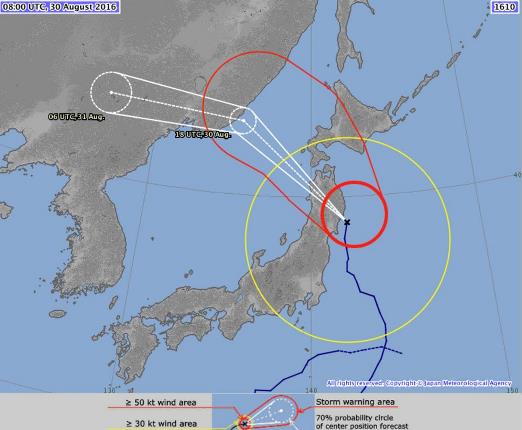Typhoon Lionrock
Status: Closed
| Type of posting | Posting date(EST): | Summary | Downloads |
|---|---|---|---|
| Landfall | 8/30/2016 1:15:00 PM |
|
Landfall | Summary
Posting Date: August 30, 2016, 1:15:00 PM
Landfall conditions
Location: Near Ofunato, Iwate Prefecture, in the Tohoku region
Date, time: Tuesday, August 30, 2016, at approximately 6:00 p.m. JST (09:00 UTC)
Minimum pressure: 970 mb
Maximum sustained wind (1 min.): 129 km/h (80 mph) at Misawa Air Base
Precipitation levels: 15 cm (6 in) as of Tuesday evening
Other hazards: High seas, storm surge, flooding rain, landslides, thunderstorms, flooding
Reported damage: Landslides, downed power lines
With strong winds, drenching rain, high surf, and coastal flooding, Typhoon Lionrock made landfall in the Tohoku region of Japan Tuesday evening (local time), near the city of Ofunato in Iwate Prefecture. Arriving a week after typhoons Mindulle and Kompasu struck Japan, Lionrock—which had the intensity of a Category 1 hurricane—brought extreme levels of precipitation to eastern and northern Honshu, Japan’s major island, which has resulted in landslides and flooding.

Typhoon Lionrock track map an hour before landfall near Ofunato, Japan, on August 30, 2016. (Source: JMA)
The first typhoon to make landfall on the Pacific side of the Tohoku region since the Japan Meteorological Agency (JMA) began record-keeping in 1951, Lionrock hit the same area devastated by the M9.0 Tohoku earthquake and tsunami in 2011, which caused massive damage to the Fukushima Daiichi nuclear power plant.
Typhoon Lionrock, which came ashore about 500 kilometers (310 miles) northeast of Tokyo, was downgraded to a tropical storm as it moved inland. Lionrock should cross the Sea of Japan by the end of the week and bring heavy rain to Russian maritime territory and northeastern China.
Reported Damage
The fourth typhoon to make landfall in Japan in 2016, Lionrock made landfall at high tide, exacerbating storm surge and resulting in flooding in many coastal areas. High wind from the storm has brought down power lines throughout the region, resulting in as many as 10,000 homes being without power.
Lionrock is expected to cause much greater damage from the inundating rain than wind. The JMA reported that by Tuesday evening 15 centimeters (6 inches) of rain had fallen in the region, and some parts of Honshu were projected to receive as much as 8 centimeters (3 inches) of precipitation per hour. Some areas of the Tohoku region were projected to receive as much as 35 centimeters (14 inches) of rain by Wednesday morning, more than they normally would see in a month.
Landslides—a constant risk in Japan—have already shut down roadways and impacted travel and remain a threat of additional damage.
Other Reported Impacts
In anticipation of Lionrock’s landfall, tens of thousands of people were advised to evacuate, according to the Fire and Disaster Management Agency. In addition, more than 100 flights were canceled in and out of the northern region of Honshu, and some bullet train service was discontinued.
Toyota shut down production lines at two plants in the region before the storm’s arrival, although they are expected to resume on Wednesday.
Tokyo Electric Power Co., which operates the heavily damaged Fukushima Daiichi Nuclear Power Plant, rushed to stabilize equipment before landfall, suspended some decommissioning, and began to closely monitor groundwater levels and seawater quality.
Exposure at Risk
Japan has strict and well-enforced construction codes, although many existing structures predate the existence of these codes. Residential exposures in Japan are dominated by wood construction; non-wood residences primarily consist of steel and concrete. Modern wood construction typically demonstrates the best performance in typhoons among all wood constructions in Japan. However, damage to roof coverings and windows can allow wind-driven rain to enter and cause extensive damage to contents. Furthermore, dislodged external components can become wind-borne debris and cause damage to surrounding structures and glazing.
Larger multi-family apartment buildings and commercial and industrial structures are generally engineered and made of reinforced concrete or steel. Complete structural collapse of engineered buildings due to typhoons is extremely rare; damage is usually confined to nonstructural components, such as mechanical equipment, roofing, cladding, and windows.
A significant portion of Japan’s industrial stock is of non-engineered light metal construction, which is one of the construction types most vulnerable to high winds. Low-rise, non-engineered commercial and industrial buildings usually perform similarly to single-family homes under typhoon conditions.
Even with modern flood-control structures, the risk of flood damage remains high in Japan. For a given flood depth/effective surge depth, a residential wood frame building generally will sustain more damage than a residential masonry building. Concrete construction is less vulnerable to flood than steel or masonry. Commercial and apartment buildings usually have stronger foundations than residential buildings, and are thus better able to resist flood loads. Water damage to machinery and contents drives most flood-related loss; also, because damage is usually limited to the lower stories of a building, high-rise buildings will experience a lower damage ratio than low-rise buildings because a smaller proportion of the building is affected.
Insurance Impact
In Japan, wind damage is typically automatically covered under standard fire insurance policies, but flood damage is not, despite the fact that Japan regularly experiences “wet” storms that deliver extreme precipitation and flooding that contribute substantially to damage.